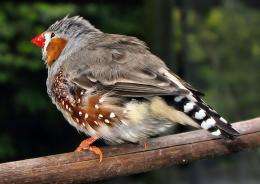August 16, 2011 report
Study of finches shows they form homosexual alliances

A new study by a team of researchers shows that for zebra finches, bonding trumps sex. Post-Doc fellow Julie Elie of the University of California and her team describe in the journal Behavioural Ecology and Sociobiology, how male finches, in the absence of females, chose to bond with other males and then to maintain such a relationship even when females are introduced afterwards.
To find out how strong the bonds are between zebra finches, who normally form male/female life-long relationship bonds, the team raised a group of all male birds to adulthood, at which point nearly half of them paired up and bonded, which the team describe as perching next to each other, singing, preening and nuzzling beaks.
Once the bonds were formed, the team then introduced females to the group. They found that of the eight male-male pairs that had bonded, five of them disregarded the females entirely, choosing instead to continue with their male partners.
Elie, in an interview with the BBC noted that selecting a social partner, regardless of gender, could be a bigger priority. In other words, for zebra finches, it appears that it’s more important that a bird find a mate for cohabitation and socialization, then for reproduction. One interesting side note, though the authors mention the types of activities the bird engage in once they form bonds, no mention is made of whether the male birds attempt to mate with one another, a rather critical factor it would seem, in labeling the birds as homosexual, rather than as just life-long pals. Also not mentioned is if female-female bonds ever occur.
Elie adds that her findings demonstrate that pair-bonding, even in animals can, be more complex than just a male and a female who meet to reproduce. She also suggests that for zebra finches at least, finding a suitable partner is more than just fun and games, it is also likely a key to survival as the birds team up to defend food they have obtained or to fight off predators.
Elie also noted that there are many examples of same-sex parings in nature, such as with gulls and albatrosses where males pair up but still mate with a female. Also, she mentions the apparently gay chin-strap penguins that lived in New York’s Central Park Zoo last year, who went so far as to hatch an artificially fertilized egg together.
© 2011 PhysOrg.com




















